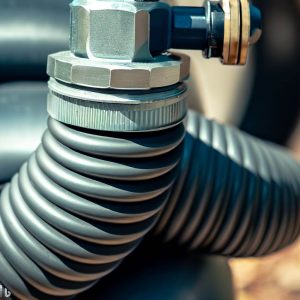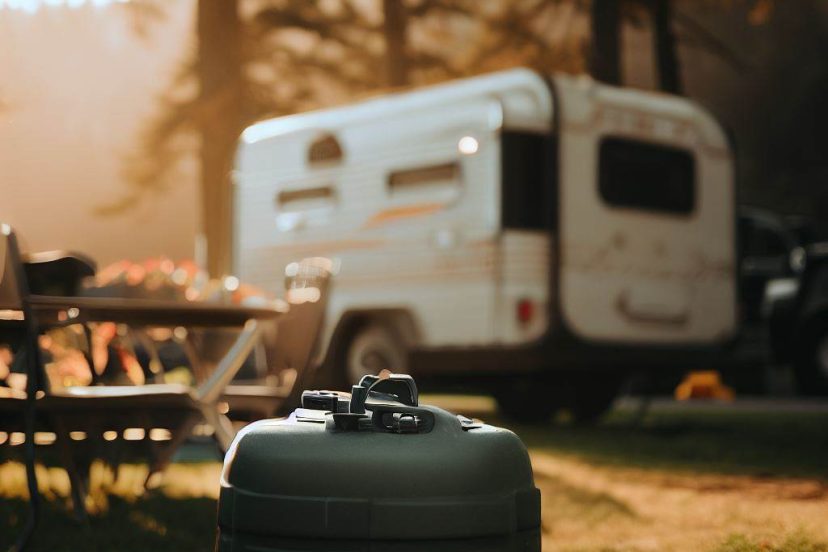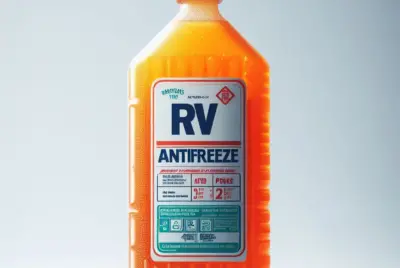Understanding the Portable RV Waste Tank
Welcome to the ultimate guide for managing your portable RV waste tank. As an avid RV camper and enthusiast, I understand the importance of maintaining a clean and hygienic camping environment. In this comprehensive guide, I will share valuable insights and tips on various aspects of RV waste management. From understanding the purpose of portable RV waste tanks to selecting the best brands, preventing odors, safely disposing of waste, using tanks in freezing temperatures, and connecting them to your RV, I’ve got you covered. So, let’s dive in and ensure your RV adventures are fresh, responsible, and worry-free.
The Essentials of the RV Waste Tank
I can’t emphasize enough the importance of understanding each component of your recreational vehicle. In particular, the portable RV waste tank often flies under the radar but is a vital component that deserves our attention.
Understanding the Portable RV Waste Tank
A portable waste tank for an RV is essentially an additional holding tank that you can connect to your RV’s existing system. Its primary purpose? To store wastewater (both black and grey) when the built-in RV holding tanks are full. This auxiliary tank can then be detached and wheeled to a dump station, allowing you to empty your waste without moving your entire RV.
RV Tanks: A Necessary Convenience
Picture this: you’ve set up camp in a beautiful, remote location where moving your RV is a considerable hassle. But oh no! Your RV holding tank is full. This is where a portable RV dump tank becomes a lifesaver. The RV dump tank offers a portable solution for your waste disposal needs, ensuring a smooth, hassle-free camping experience.
Different Types of RV Portable Waste Tanks
The beauty of RV portable waste tanks lies in their variety. From differing capacities to unique features, these RV tanks are designed to cater to a wide range of needs and preferences. The most popular variations include the two-wheel design for easy maneuverability and four-wheel versions for those needing to transport larger volumes.
Why Portable RV Waste Tanks are Essential
A portable RV waste tank is an indispensable tool for any RV camping enthusiast. It adds convenience, enhances your camping experience, and ensures environmental responsibility by preventing improper waste disposal. Remember, a clean campsite isn’t just more enjoyable; it’s also respectful to nature and fellow campers.
So, next time you’re planning your RV adventure, make sure your portable waste tank RV is in tow. It’s one little addition that makes a big difference!
The Perfect Fit: Sizing Up Your Portable RV Waste Tank
If there’s one thing I’ve learned from my RV camping escapades, it’s the importance of the portable RV waste tank capacity. Ensuring you have the right-sized tank makes the difference between a relaxing getaway and an unfortunate series of waste disposal trips.
The Ins and Outs of Portable RV Waste Tank Capacity
So, what is the capacity of a standard portable waste tank for RV? Well, the beauty lies in the fact that there isn’t really a “standard” capacity. Instead, portable RV waste tanks come in a range of sizes, typically between 5 to 42 gallons. Your choice of RV dump tank capacity will depend on a few factors, most importantly your RV’s holding tank size, the number of people onboard, and the duration of your trip.
Choosing the Right RV Tanks Capacity
You might be wondering, how do I choose the right RV portable waste tank? It’s all about balance. Too small, and you might find yourself emptying it frequently, which can be a hassle. Too large, and it may be tough to transport when full. Ideally, you’d want a portable RV tank dump that holds at least half the capacity of your RV holding tanks. This gives you enough wiggle room for longer stays while still being manageable to move.
Capacity and Your RV Lifestyle
Lastly, remember that your lifestyle and camping habits play a big role. Are you the type who prefers campgrounds with full hookups, or are you more into boondocking in off-grid locations? If you’re more of the latter, a larger portable RV dump tank may be worth considering.
Finding the Right Portable RV Waste Tank Size
In essence, understanding the capacity of your portable RV waste tank is an essential part of RV camping preparation. With the right-sized tank in your arsenal, you’re all set for a hassle-free, enjoyable camping adventure. So go ahead, make the right choice, and hit the open road!
Spotless Adventures: Cleaning and Maintaining Your Portable RV Waste Tank
RV life is an adventure, and it’s crucial to keep your home on wheels in tip-top shape, including your portable RV waste tank. Cleaning and maintaining this essential device ensures a hygienic, worry-free, and enjoyable camping experience.
Properly Cleaning Your Portable RV Waste Tank
So, how do you ensure your portable waste tank for RV stays fresh and clean? It’s simpler than you might think! First, you’ll need to drain the tank at a designated dump station. Once empty, thoroughly rinse the portable RV dump tank with clean water. To eliminate lingering odors and sanitize it, consider using a specialized tank cleaner or a simple mix of water and mild detergent. Remember, a clean RV waste tank isn’t just about odor control, it’s about maintaining a healthy and sanitary living environment in your RV.
And I think it should go without mentioning, but be sure to wear gloves when dealing with waste water. Whether you are at a one of the many full hookup sites at the campground, or emptying your black tack at a wastewater facility make sure to protect your skin and clothing. Even if you are just opening the gate valve or only working with gray tanks.
Ongoing Maintenance of Your RV Dump Tank
Regular cleaning is just the start. Good RV portable waste tank maintenance also involves checking for leaks and damage, ensuring the wheels and handles are in working order, and lubricating the valves as needed. Regularly servicing your portable RV tank dump can significantly prolong its lifespan, saving you from costly replacements in the long run.
A Little Extra Care Goes a Long Way
Beyond the basics, consider using tank deodorizers and waste digesters between cleanings to control odors and break down waste in your RV holding tanks. Not only will these products make your RV smell fresher, but they’ll also make the next tank cleaning process a breeze.
Make Your Portable RV Waste Tank Last
In essence, the key to a long-lasting portable RV waste tank lies in regular cleaning and proper maintenance. So next time you’re on an RV adventure, don’t forget these simple steps! Your portable waste tank (and your nose) will thank you!
The Best Brands of Portable RV Waste Tanks
In the world of RV camping, a reliable portable RV waste tank is worth its weight in gold. But with so many brands out there, how do you choose the best one? As an RV camping aficionado, I’ve got some insights that might just help.
Thetford: The Pioneers of Portable Waste Tank RV
When it comes to reliable and user-friendly portable RV dump tanks, Thetford is a name that stands out. With their innovative design and attention to detail, Thetford’s RV portable waste tanks are built to last and easy to use. Their SmartTote2 series, for instance, boasts an integrated storage compartment for accessories and a perma-store hose for convenient emptying.
Barker: The Go-To Brand for RV Tanks
Another brand that consistently hits the mark is Barker. Their RV waste tanks have won the hearts of many RV campers, myself included, with their durability and practical design. The Barker 4-Wheeler Tote Tank, with its pneumatic wheels and bobber gauge, is a camper’s dream, effortlessly combining convenience and functionality.
Camco: Quality RV Dump Tanks That Deliver
Last but certainly not least, Camco’s Rhino series of RV holding tanks deserves a special mention. Known for their rugged construction and easy-to-use features, Camco’s portable RV waste tanks are built to withstand the rigors of the open road while making waste disposal a breeze.
Choosing the Best Portable RV Waste Tank
In the end, the best portable RV waste tank brand is the one that suits your specific needs and lifestyle. Whether you choose Thetford, Barker, or Camco, remember that a high-quality waste tank is an investment in your RVing comfort and convenience. So, consider your options carefully, and happy camping!
A Clean Getaway: Safely Disposing of Waste from Your Portable RV Waste Tank
As an RV camper, I understand the importance of proper waste disposal from your portable RV waste tank. It’s not just about convenience; it’s also about maintaining a clean and responsible camping environment. So, how do you ensure a safe and hygienic waste disposal process? Let me share some helpful suggestions.
Follow Local Regulations and Guidelines
Before you hit the road, familiarize yourself with the waste disposal regulations and guidelines of the areas you’ll be visiting. Many campgrounds and RV parks have specific dump stations where you can safely dispose of your waste. By following these rules, you’re not only being a responsible camper but also helping to protect the environment.
Use Dedicated Dump Stations
When it’s time to empty your portable waste tank for RV, always utilize designated dump stations. These stations are equipped with proper facilities to handle waste disposal, including sewer connections and rinse hoses. Using these stations ensures that the waste is directed to the appropriate treatment systems, preventing contamination of the surroundings.
Practice Good Hygiene and Cleanliness
Maintaining good hygiene during the waste disposal process is essential. Always wear protective gloves and use disinfectant wipes or sprays to clean any surfaces that come in contact with the waste tank or hoses. Dispose of the used gloves and wipes properly to avoid any potential spread of bacteria or pathogens.
Responsibly Managing Your Waste
Proper waste disposal from your portable RV waste tank is a crucial aspect of RV camping. By following local regulations, using designated dump stations, and practicing good hygiene, you’re taking important steps toward keeping your camping environment clean and safe. Let’s all do our part to ensure a pleasant and responsible RV camping experience for ourselves and future campers alike!
Choosing the Perfect Portable RV Waste Tank: Essential Features to Consider
Selecting the right portable RV waste tank can make a world of difference in your camping experience. But with so many options available, how do you decide? Don’t worry—I’m here to help you navigate through the features and find the perfect fit for your needs.
Capacity: Size Matters
One of the first features to consider is the capacity of the portable waste tank for RV. The size you choose depends on factors such as the number of people in your RV and the duration of your trips. A larger capacity tank allows for longer periods between emptying, while a smaller one may be more manageable for shorter trips. Strike the right balance based on your specific needs.
Durability: Built to Last
 When investing in a portable RV dump tank, durability is key. Look for tanks made from sturdy materials that can withstand rough terrain and frequent use. High-quality tanks made of robust polyethylene or heavy-duty plastics are excellent choices. Remember, your RV holding tank deals with waste, so you want a tank that won’t let you down.
When investing in a portable RV dump tank, durability is key. Look for tanks made from sturdy materials that can withstand rough terrain and frequent use. High-quality tanks made of robust polyethylene or heavy-duty plastics are excellent choices. Remember, your RV holding tank deals with waste, so you want a tank that won’t let you down.
Portability: Convenience on Wheels
The portability of the tank is another crucial factor. Opt for a tank that features sturdy, easy-grip handles and smooth-rolling wheels. These features make it a breeze to transport your tank to the dump station without straining your back or struggling with cumbersome equipment. A well-designed handle and wheel system can save you time and effort.
Easy-to-Use Features: Simplify Your Cleanup
Consider the ease of use features offered by the tank. Look for a tank with a wide opening for easy filling and cleaning. A secure and leak-proof cap ensures no unwanted surprises during transportation. Some tanks also come with integrated hose storage compartments and hose rinse systems, making the dumping process more convenient and hygienic.
A Well-Equipped Portable RV Waste Tank
When buying a portable RV waste tank, remember to consider the capacity, durability, portability, and ease of use. Finding the right balance between these features will ensure a hassle-free waste disposal experience during your RV adventures. So, go ahead and choose a tank that meets your requirements, and enjoy a clean and convenient camping journey!
Embracing the Chill: Using a Portable RV Waste Tank in Freezing Temperatures
The thrill of hitting the road in any season, including winter, can be exciting. But when it comes to portable RV waste tanks, you might wonder if they can withstand freezing temperatures. Well, fear not! Let me shed some light on this topic and provide you with helpful suggestions.
Understanding the Impact of Freezing Temperatures
Freezing temperatures can pose challenges when using a portable waste tank for RV. The water inside the tank and hoses can freeze, causing potential damage. The expansion of freezing water can crack the tank or make it difficult to empty. So, it’s important to take precautions to protect your tank.
Insulating and Heating Solutions
To use your portable RV waste tank in freezing temperatures, consider insulating it with foam insulation or using an insulated tank cover. These measures can help maintain a higher temperature inside the tank, preventing freezing. Additionally, you can wrap heat tape or electric pipe heating cables around the hoses to prevent them from freezing.
Draining and Antifreeze: Essential Steps
Proper drainage is crucial in freezing temperatures. Ensure that your tank is completely emptied after each use to prevent any remaining liquid from freezing and causing damage. After emptying, consider adding non-toxic RV antifreeze to the tank. This antifreeze lowers the freezing point of the residual water, offering an extra layer of protection.
Cold-Weather Camping with a Portable RV Waste Tank
While using a portable RV waste tank in freezing temperatures requires extra care, it is possible with the right precautions. Insulating the tank, protecting the hoses, and ensuring thorough drainage are key steps to prevent freezing-related issues. By taking these measures, you can continue to enjoy your RV adventures even in the coldest of winters.
Remember, safety should always be a priority. If you’re unsure or uncomfortable with using a portable waste tank in freezing temperatures, it’s best to consult with experts or wait for milder weather conditions. Stay warm and happy camping!
Keeping it Fresh: Tips for Preventing Odors from Your Portable RV Waste Tank
The last thing you want is unpleasant smells lingering around your living space. But fret not! I’ve got some helpful tips to ensure your RV stays fresh and odor-free.
Proper Ventilation: Let the Air Flow
One of the most effective ways to prevent odors from your portable waste tank for RV is to ensure proper ventilation. Keep your RV’s vents and windows open when possible, allowing fresh air to circulate and push out any potential odors. Consider using RV roof vent covers that allow for ventilation even during inclement weather.
Use Tank Deodorizers: Freshen Up the Tank
Tank deodorizers are a lifesaver when it comes to keeping your RV holding tanks smelling fresh. These products are specifically designed to neutralize odors and break down waste. Choose deodorizers that are safe for septic systems and environmentally friendly. Drop-in tablets or liquid deodorizers added directly to the tank are convenient options that can provide long-lasting freshness.
Regular Cleaning and Maintenance: Stay on Top of it
Regular cleaning and maintenance of your portable RV waste tank are essential for odor prevention. Clean the tank thoroughly after each use, ensuring no waste or residue is left behind. Use a tank cleaner or a mixture of water and mild detergent to sanitize and eliminate any odors. Don’t forget to rinse all the hoses and connectors as well.
A Breath of Fresh Air
By implementing these tips, you can prevent odors from infiltrating your RV and enjoy a fresh and pleasant camping experience. Proper ventilation, the use of tank deodorizers, and regular cleaning and maintenance are key to keeping your portable RV waste tank odor-free. So, let’s embrace the great outdoors without any unwanted scents! Happy camping!
Navigating the Rules: Regulations for Using and Emptying Portable RV Waste Tanks
Understanding the rules and regulations surrounding the use and emptying of portable RV waste tanks is crucial for a seamless and responsible camping experience. It’s important to ensure that we’re not only enjoying our adventures but also respecting the environment and the communities we visit. Let’s dive into the regulations and guidelines that RV campers should be aware of.
Local Regulations: Know Before You Go
Different regions and campgrounds may have specific regulations regarding the use and emptying of portable waste tanks for RV. It’s essential to research and familiarize yourself with these regulations before embarking on your trip. Check with the campground or RV park you plan to visit to understand their policies and any restrictions in place.
Dump Stations: The Proper Disposal Route
Using designated dump stations is the recommended and responsible way to empty your portable RV waste tank. These stations are equipped with the necessary infrastructure to handle waste disposal safely and efficiently. Avoid disposing of waste in unauthorized areas, such as public restrooms or natural bodies of water, as this can harm the environment and violate regulations.
Environmental Considerations: Protecting Nature
When emptying your portable RV dump tank, it’s important to be environmentally conscious. Ensure that you’re using biodegradable and environmentally friendly tank treatments and cleaning agents. Avoid dumping any harmful chemicals or non-biodegradable materials into the tank. By taking these measures, you’re playing your part in preserving the natural beauty of the camping areas and protecting the ecosystems.
Responsible RV Camping
By adhering to local regulations, utilizing designated dump stations, and being mindful of the environment, you can enjoy your RV camping adventures while minimizing your impact. Remember, being a responsible camper not only ensures a positive experience for yourself but also helps preserve the camping experience for future generations. Let’s continue to explore and enjoy nature while leaving it pristine for others to enjoy as well!
Seamless Connection: Connecting a Portable RV Waste Tank to Your RV
 As an RV camping enthusiast, I know the importance of a smooth and efficient connection between your portable RV waste tank and your RV. Properly connecting the tank ensures easy waste disposal and a hassle-free camping experience. Let me share some helpful suggestions on how to make this connection seamless.
As an RV camping enthusiast, I know the importance of a smooth and efficient connection between your portable RV waste tank and your RV. Properly connecting the tank ensures easy waste disposal and a hassle-free camping experience. Let me share some helpful suggestions on how to make this connection seamless.
Determine the Appropriate Connection Point
The first step is to locate the connection point on your RV where the waste tank will be attached. Most RVs have a designated outlet specifically for connecting a waste tank. This outlet is typically located near the RV’s waste-holding tanks. Look for a threaded connection or a bayonet-style fitting that matches the connection on your portable waste tank.
Attach the Hose Securely
Once you’ve located the connection point, it’s time to attach the hose. Ensure that the hose is securely connected to both the outlet on your RV and the fitting on your portable waste tank. Use hose clamps or other securing mechanisms to prevent any leaks during the waste disposal process. It’s crucial to have a tight and secure connection to avoid any potential mess or accidents.
Test for Leaks and Secure the Hose
After connecting the hose, it’s essential to test for leaks. Fill the waste tank partially with water and check for any signs of leakage. If you notice any leaks, tighten the connections or replace any faulty parts. Once you’re confident that the connection is leak-free, secure the hose in a way that keeps it elevated and away from the ground to ensure efficient drainage.
A Well-Connected Waste Disposal System
By following these steps, you can connect your portable RV waste tank to your RV seamlessly, allowing for easy and hygienic waste disposal. A proper connection ensures a clean and hassle-free camping experience. So, let’s get connected and enjoy the open road without worrying about waste management!
Conclusion:
Congratulations! You are now equipped with the knowledge and tips to effectively manage your RV waste and ensure a clean and hassle-free camping experience. By understanding the purpose and capacity of portable RV waste tanks, selecting reliable brands, following proper cleaning and maintenance practices, adhering to local regulations, preventing odors, handling freezing temperatures, and connecting the tanks securely, you can enjoy the open road with peace of mind. So, pack up your RV, embark on new adventures, and let responsible waste management be a part of your unforgettable journey. Happy camping!
FAQs
Can I use a regular hose for emptying my portable RV waste tank?
No, it is not recommended to use a regular garden hose for emptying your portable RV waste tank. Regular hoses are not designed to handle waste materials and may contaminate the water source. It is best to use a dedicated RV sewer hose specifically designed for waste disposal.
How often should I empty my portable RV waste tank?
The frequency of emptying your portable RV waste tank depends on various factors such as the tank’s capacity, the number of people using the RV, and the duration of your camping trip. As a general guideline, it is advisable to empty the tank when it is about three-quarters full to prevent any overflow or unpleasant odors.
Can I dump my RV waste tank at home?
Dumping RV waste at home may not be allowed in many residential areas due to environmental regulations and concerns. It is best to use designated dump stations specifically designed for proper waste disposal. These stations are equipped with the necessary infrastructure to handle waste safely and responsibly.
Are there any alternatives to using chemicals for tank deodorization?
Yes, there are alternative methods for tank deodorization. Some RVers prefer using natural alternatives such as enzyme-based or bioactive tank treatments that use bacteria to break down waste. Additionally, using baking soda or vinegar as natural odor eliminators can also be effective.
Can I use my portable RV waste tank for storing fresh water?
No, portable RV waste tanks should not be used for storing fresh water. These tanks are specifically designed for waste disposal and may not have the necessary materials or components to ensure the safety and cleanliness of fresh water. It is essential to use dedicated freshwater tanks or containers for storing drinking and cooking water.
Remember, it is always recommended to follow local regulations, manufacturer guidelines, and best practices for RV waste management to ensure a safe, clean, and responsible camping experience.





